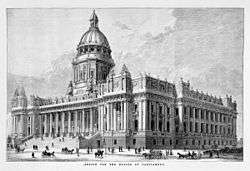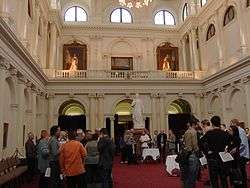Parliament House, Melbourne
| Parliament House | |
|---|---|
| Melbourne | |
 Parliament House in 2010 | |
| General information | |
| Type | Parliament |
| Architectural style | Neoclassical |
| Location | Victoria |
| Address | Spring Street, Melbourne |
| Country | Australia |
| Current tenants | Government of Victoria |
| Construction started | 1855 |
| Completed | 1929 |
| Opened | 1856 |
| Client | Governor of Victoria Charles Latrobe |
| Design and construction | |
| Architect | Charles Pasley & Peter Kerr |
| Engineer | John George Knight |
| Designations | Victorian Heritage Register |
| Website | |
| www.parliament.vic.gov.au | |


Parliament House, Melbourne was constructed between 1855 and 1929 and is located on Spring Street in East Melbourne, Victoria. It has served as both the seat of the Parliament of Victoria (1855–1901, 1927–present) and as the seat of the Federal Parliament of Australia (1901–27).
The building is listed on the Victorian Heritage Register[1] and celebrated its 150th anniversary in 2005–6.[2]
Development and design
Site
The Victorian gold rush and population boom led calls for greater democracy and a home for political debate in Victoria.[3] Prior to the Colony of Victoria acquiring self-government in 1851, Governor Charles La Trobe instructed Surveyor General Robert Hoddle to select a site for the colony's new parliament to meet. Hoddle selected a site on the eastern hill at the top of Bourke Street, which commanded a view over the entire city. It was not until April 1854 that Eastern Hill, the current Spring Street site, was formally agreed to due to ongoing disagreements over the best location.[4]
Design
A competition was held to design the new building and John Knight's design won the first prize of £500, but was deemed unsuitable.[3] The Colonial Engineer Charles Pasley subsequently produced his own design. Observers have suggested that his design borrowed heavily from Leeds Town Hall, which was built between 1853 and 1858 and is still considered to be among the finest civic buildings in the world. The design was later modified by an architect in Pasley's office, Peter Kerr. The building is an example of Neoclassical architecture.
Construction and completion
Chambers: 1855–1856
Construction began in December 1855 and was managed by the original competition designer John Knight, who also happened to be on Pasley's staff.[4] The chambers for the Victorian Legislative Assembly and the Victorian Legislative Council were finished in 1856, at which time Bourke Street ran between the two chambers. The building opened and the Victorian Government first sat there in 1856.
Parliament House was then extended, in stages, to the present state between 1856 and 1929.
Library and Eastern Wing: 1858–1860
Construction of the Library and eastern wing began in 1858 and was completed in 1860. With the library complete, the two legislative chambers were joined at the rear, resulting in a `U-shaped' building. The classical architectural detail of the east facade were noted as the first expression of Peter Kerr's vision for the building.[4] No further construction took place for 18 years, however the first set of electrical bells used to call members to divisions were installed circa 1877.
Queen's Hall, Vestibule and Proposed Dome: 1879–1882
In 1878 a Royal Commission was formed to oversee continued construction. It tabled several changes, including the addition of a large dome, the appointment of Peter Kerr as leading architect and a resumption of construction.[5] Subsequently, the Great Hall (now Queen's Hall) and vestibule were completed in 1879.
Queen's Hall was used for formal receptions and banquets, while the Vestibule offered a formal entry to Parliament House. Especially noteworthy in the Vestibule was the intricate mosaic of Minton floor tiles, one roundel of which bore the words from Proverbs 11:14 `Where no Counsel is the People Fall; but in the Multitude of Counsellors there is Safety'.[4]
After completion of the vestibule a dome was to be added, however the quality of stone used in construction until that point raised concern. Although eventually approved to support the dome in 1882, the assessment delayed construction and the dome was eventually abandoned.
Colonnade, Portico and Subsequent Additions: 1883–1929
At the height of the great boom fuelled by the gold rush, it was decided to add a classical colonnade and portico facing Spring St, which today gives the building its monumental character. The western facade and colonnade were completed in 1888.
The north wing was completed in 1893 and refreshment rooms at the back of the building were added in 1929.[4]
Commonwealth of Australia's Parliament House
From 1901 to 1927 Parliament House was the first home of the Commonwealth of Australia's Federal Government, since the new capital city envisaged in the Australian Constitution did not yet exist and there were long delays in finding a site and commencing construction. During these years the Victorian Parliament met in the Royal Exhibition Building in Carlton.[4]
Many of the major events of the early federal period took place in this building, including the formation of the Federal Parliamentary Australian Labour Party, the "fusion" of the Free Trade Party and the Protectionist Party into the first Liberal Party in 1909, the declaration of the Great War in 1914, and the split in the Labour Party over conscription in 1916.
Modern use and developments
The building resumed its original use as the Victorian Parliament chambers in 1928. Parliament House was then listed on the Victorian Heritage Register in 1982[1] and celebrated its 150th anniversary in 2005–6.[2]
Several modern governments have expressed interest in completing Pasley and Kerr's original design by constructing the dome but were deterred by the substantial cost. Notably, the 1992 Kennett government established a committee to examine building the dome. Kennett and the then Opposition Leader John Brumby reached an agreement in 1996 for the building to be completed by the turn of the century. The idea was then abandoned by Kennett when he learned the original site of the sandstone mined for the building, now within Grampians National Park, could not be re-mined.[6]
In 2016 a $40 million two-storey office building will be constructed in the gardens of Parliament House for MP's use. The building is embedded into the landscape to specifically reduce its impact on Parliament House and other nearby buildings.[7]
Gallery
 Victoria Parliament from Spring Street
Victoria Parliament from Spring Street.jpg) Colonnades and Portico
Colonnades and Portico- Australian flag at half-mast on 10th anniversary of the Bali bombings, 12 October 2012
.jpg) Building Entrance
Building Entrance.jpg) Steps and Facade from Spring Street
Steps and Facade from Spring Street
References
- 1 2 "Parliament House (including grounds, works and fences), Victorian Heritage Register (VHR) Number H1722, Heritage Overlay HO175". Victorian Heritage Database. Heritage Victoria.
- 1 2 Celebrate 150 Years (archived website at Pandora)
- 1 2 "~ GOLD ~". www.sbs.com.au. Retrieved 2016-08-16.
- 1 2 3 4 5 6 History of Parliament House at Parliament of Victoria
- ↑ http://www.parliament.vic.gov.au/papers/govpub/VPARL1878No80.pdf
- ↑ Heraldsun: Dome sweet dome, 31 July 2008
- ↑ "$40m addition to Vic Parliament House". Retrieved 2016-08-16.
External links
| Wikimedia Commons has media related to Parliament House, Melbourne. |
Coordinates: 37°48′40″S 144°58′24″E / 37.811055°S 144.97329°E
